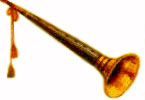Shehnai
Origins
and brief history of the Shehnai
How to play the Shehnai
The Shehnai, double-reeded instrument of the wind category is one of the most ancient instrument used in India. Shehnai is mainly an outdoor instrument played particularly on occasions considered auspicious such as processions and weddings.
The Shehnai is a tube that gradually widens towards the lower end. It usually has eight or nine holes. The instrument is made of dark, close grained black wood and has a metal bell fixed to the border end. The length of the instrument is one and a half to two feet. The reed is fixed at the narrow blowing end. The reeds used in Shehnai is made of pala grass. Spare reeds and an ivory needle with which the reeds are adjusted are attached to the mouth piece.
Shehnai is a most sensitive instrument. It is actually the way the lips and tongue play upon the reed mouthpiece and the manner in which the holes are opened or closed with the fingers which render the semitone and quarter tones very effectively and attractively.
Origins and brief history of the Shehnai
The Shehnai is also called the oboe of northern India. It may have evolved from the Persian Nai. There are depictions of the Nai on Egyptian tombs dating to 3000 B.C. Historically, in India, the Shehnai was one of the nine instruments associated with the ensembles of royal courts. It is called Mangal Vadya, which translates to “auspicious instrument.” The auspicious sound of the Shehnai is the reason it is associated with the religious ceremonies. Today, the Shehnai is still played in temples. This status has made it a necessary instrument in north Indian weddings and festivals.
How to play the Shehnai
The reed mounts in the mouth piece, the upper end, on the outside. This instrument has a sealed air chamber. Do not try to remove the bell from the shaft. When playing, your lips are placed on the upper end, this places the reed inside your mouth. Your mouth is now part of the instrument and acts as an air chamber. Prior to playing the reed must be soaked to soften it. You may soak the reed for up to 5 minutes. Test the reed occasionally to see if it has the sound you like, there is no need to over soak it.
The fingers of the right hand cover the four bottom holes. The fingers of the left hand play the upper four holes. Blow steady but do not blast the air through the instrument. Some players adjust the instrument’s sound by partially or completely filling some holes with wax. As you play the reed will be kept damp by your breath. You may find that it becomes too damp and you will need to dry it out. It can be left to dry naturally, never put it in sunlight or near heat. You can adjust the opening of the reed by placing a clip on the reed when it dries to minimize the opening. Or, dry it with a toothpick between the reeds to increase the opening. As you play, you will become familiar with the style of reed that works best for you.
